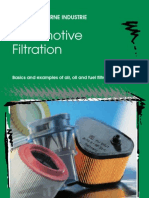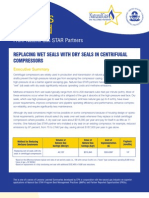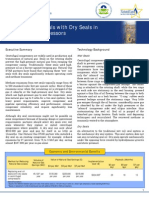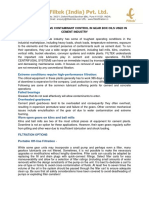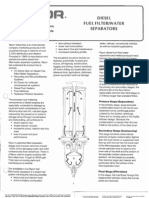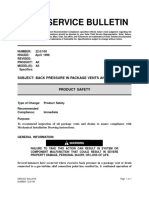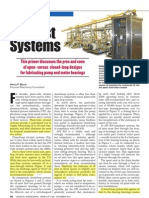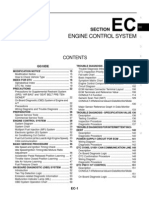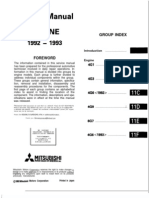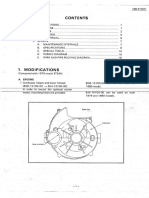Crankcase Ventilation Filtration Systems For Diesel Engines (TSB 05-1)
Crankcase Ventilation Filtration Systems For Diesel Engines (TSB 05-1)
Uploaded by
Jorge Cuadros BlasCopyright:
Available Formats
Crankcase Ventilation Filtration Systems For Diesel Engines (TSB 05-1)
Crankcase Ventilation Filtration Systems For Diesel Engines (TSB 05-1)
Uploaded by
Jorge Cuadros BlasOriginal Title
Copyright
Available Formats
Share this document
Did you find this document useful?
Is this content inappropriate?
Copyright:
Available Formats
Crankcase Ventilation Filtration Systems For Diesel Engines (TSB 05-1)
Crankcase Ventilation Filtration Systems For Diesel Engines (TSB 05-1)
Uploaded by
Jorge Cuadros BlasCopyright:
Available Formats
April 2005
Page 1 of 2
Technical Service Bulletin 05-1
Crankcase Ventilation Filtration Systems for Diesel Engines
Overview
During normal diesel engine combustion, a significant volume of combustion gas and
particles escape past the piston rings and enter the crankcase. This blow-by gas
must be vented through a tube into the atmosphere to avoid pressurizing and
damaging the oil pan. After mixing with oil mist in the crankcase, the gases and oil
vapor either condense and drip out of the vent tube onto the ground, or enter into the
atmosphere as pollutants.
In the near future, worldwide environmental regulations will require crankcase
emissions to be recycled or trapped in a closed system on the engine. Various
technologies and devices are available now to remove the bulk of oil vapors and
particles from the crankcase emission stream.
EPA Controls of Crankcase Emissions
Typical crankcase emissions regulated by the EPA are diesel particulate matter, some
nitrogen oxides, hydrocarbons, and carbon monoxide. Fine oil droplets, soot, and
vapors generated in the diesel engine crankcase range in size from 0.1 to 10
micrometers or microns. The concentration and distribution of these particles varies
greatly with engine rpm and load. Effective for 2007 model year highway trucks,
crankcase emissions will be measured and included with exhaust emission results.
Diesel engine manufacturers will be expected to control crankcase emissions by
re-routing them back to the intake for re-combustion, or routing them to the exhaust
stream, upstream of the exhaust emission control devices. Since crankcase
emissions contain engine damaging contaminants, these emissions must be cleaned
and filtered before they can be recycled back through the engine.
Crankcase Emission Filtration Technologies
Crankcase ventilation or filtration systems must work across a wide range of particle
sizes, flow velocities, pressures, and temperatures. No single technology is available
to cover all diesel engine applications. Diesel engine manufacturers must tailor the
crankcase filter system to fit their unique applications.
Current open to atmosphere crankcase emission filtration systems are designed to
recover nuisance oil vapors before they escape to the ground or coat engine
components. On and off highway vehicles may have one or more stages of baffles
April 2005
Page 2 of 2
and traps to minimize oil dripping. The baffles and traps may use metal mesh and
depth style media to condense and recover fine oil mists. Oil vapor management is
also important in marine engine rooms or stationary power generation applications in
hospitals and other enclosed environments.
Open crankcase ventilation or filtration systems are generally simple and relatively
inexpensive when compared to the closed systems. Open systems rarely need
service, and go a long way to reduce and recover oil vapors. However, open systems
have low efficiencies and do nothing to reduce polluting gases.
Closed crankcase ventilation or filtration systems must efficiently remove and filter oil
and soot to protect turbochargers and aftercoolers, or exhaust system components,
depending on the diesel engine manufacturers strategy to close the crankcase
system. In the case of systems designed to return gases to the air intake, the outlet of
the crankcase filter is routed ahead of the turbocharger and after the air filter. This
system requires a pressure balancing mechanism to avoid damaging the oil pan seals.
With a new air filter in place and under idle conditions, it is possible that the oil pan
pressure may exceed safe limits across a crankcase filter. In that case, a valve opens
to temporarily bypass the crankcase filter and relieve oil pan over pressure. Under
heavy load and/or a partially plugged air filter, there may be a net vacuum on the oil
pan. In this case a valve in the crankcase filter limits vacuum in the crankcase until
pressure builds again. Regardless of the technology, a closed system crankcase filter
maintains normal vapor pressures in the engine.
Currently, there are two available high efficiency technologies to filter crankcase
ventilation emissions in a closed system. One is through centrifugal action, which
coalesces oil and soot out of the vapor stream and returns it to the oil pan. Centrifugal
filters can be passive or mechanically driven. They have the advantage of not
requiring periodic cartridge filter replacement, but are generally less efficient than
cartridge filter technologies. Crankcase filters using pleated or depth style media,
have the advantage of higher efficiency across a wider engine load and rpm operating
range. They also remove and hold contaminants and soot. Their disadvantage is the
need for periodic filter element replacement. Other types of technologies may be
developed to meet any future needs and emission regulations.
For additional information, contact:
Filter Manufacturers Council
P.O. Box 13966
Research Triangle Park, NC 27709-3966
Phone: 919/406-8817 Fax: 919/406-1306
Used Filter Recycling Hotline: 800/993-4583
www.filtercouncil.org
Administered by Motor & Equipment Manufacturers Association
You might also like
- Manual Tecnico Motor CAT 3508Document661 pagesManual Tecnico Motor CAT 3508Armando Orta100% (5)
- Cat 3056 EDocument166 pagesCat 3056 EFranco Mayanga100% (9)
- Subaru Fault Codes PDFDocument5 pagesSubaru Fault Codes PDFEder BarreirosNo ratings yet
- The Quality ToolboxDocument84 pagesThe Quality ToolboxJorge Cuadros BlasNo ratings yet
- Filtration in Fahrzeugen EnglDocument49 pagesFiltration in Fahrzeugen EnglmahendrapatilNo ratings yet
- 02 - Motor C6.4Document40 pages02 - Motor C6.4Deyvi Cconocuyca Huallparimachi88% (16)
- Technical Data: @perkinsDocument6 pagesTechnical Data: @perkinsHendra SyalalaNo ratings yet
- C87 Te4Document3 pagesC87 Te4Daniel Muratalla100% (1)
- PCVDocument20 pagesPCVyared abebeNo ratings yet
- Filtro de AireDocument2 pagesFiltro de AireAndres Uzzi GuzmanNo ratings yet
- Crankcase Ventilation Systems LEBW4958-04Document19 pagesCrankcase Ventilation Systems LEBW4958-04pontianak.areaa2No ratings yet
- Lessons LearnedDocument13 pagesLessons LearnedBilaljafraniNo ratings yet
- Filtration With Offline Oil Filters SDN Rev Feb 2013 01 PDFDocument7 pagesFiltration With Offline Oil Filters SDN Rev Feb 2013 01 PDFLatifahabubakar EifaNo ratings yet
- PureVent Centrifugal Oil Mist Separator Cleaning Crankcase Gas - 1009Document4 pagesPureVent Centrifugal Oil Mist Separator Cleaning Crankcase Gas - 1009Shivananda PatraNo ratings yet
- AU-Seal OilDocument4 pagesAU-Seal OilPradeep_VashistNo ratings yet
- FDRB538UK SuperimpactorDocument12 pagesFDRB538UK SuperimpactordanieljcopleyNo ratings yet
- Solutions For Professional Service CentresDocument2 pagesSolutions For Professional Service Centresanon_354542422No ratings yet
- Experiment No. 4Document3 pagesExperiment No. 4monu61316No ratings yet
- Emission Control Systems: Chapter 4 Part DDocument2 pagesEmission Control Systems: Chapter 4 Part DstoicaNo ratings yet
- Diagnose and Repair Exhaust SystemsDocument38 pagesDiagnose and Repair Exhaust Systemslittleprayerbyjacks100% (1)
- 6.7 PSD Exhaust OverviewDocument2 pages6.7 PSD Exhaust OverviewjonNo ratings yet
- Dry Gas Seal 4Document8 pagesDry Gas Seal 4anshug1016No ratings yet
- Wet SealsDocument8 pagesWet Sealsasadiqbal127100% (1)
- Diesel Particulate Filter WorksDocument7 pagesDiesel Particulate Filter WorksVijayaprabakar VNo ratings yet
- Fleetguard - Understanding Engine Oil Contamination and FiltrationDocument4 pagesFleetguard - Understanding Engine Oil Contamination and Filtrationalfatih1407497No ratings yet
- Exhaust SystemDocument63 pagesExhaust Systemjamie.crassNo ratings yet
- Rocla Oil Grease SeparatorsDocument12 pagesRocla Oil Grease Separatorsmoloko masemolaNo ratings yet
- Caring: For A CompressorDocument5 pagesCaring: For A CompressorMohammed Suhail KavvayiNo ratings yet
- Dry Gas Versus Wet Gas Compressor SealsDocument5 pagesDry Gas Versus Wet Gas Compressor Sealsasimozma100% (1)
- Idrabel Tank CleaningDocument8 pagesIdrabel Tank CleaningMuTe JameeLa BimbimShopNo ratings yet
- Mo 4 811Document8 pagesMo 4 811eng_ebrahim_2000No ratings yet
- 94 2R1 PDFDocument3 pages94 2R1 PDFRam KumarNo ratings yet
- Gear Box Oil Filtration in Cement Mills PDFDocument2 pagesGear Box Oil Filtration in Cement Mills PDFShirish Patwardhan100% (1)
- TCL Training Day 2Document140 pagesTCL Training Day 2kixiliy439No ratings yet
- Cummins Service Bulletin Number 3379000, Air Requirements For Your EngineDocument24 pagesCummins Service Bulletin Number 3379000, Air Requirements For Your EngineMike PerryNo ratings yet
- Donaldson Purify and Pressure FiltersDocument132 pagesDonaldson Purify and Pressure FiltersCentral HydraulicsNo ratings yet
- Cat Engines - Air Inlet and Exhaust SystemDocument10 pagesCat Engines - Air Inlet and Exhaust Systemkevinmmp350% (2)
- Marine Diesel Engine II - Fuel Service and Transfer SystemDocument48 pagesMarine Diesel Engine II - Fuel Service and Transfer SystemAnas DarwishNo ratings yet
- Lafarge Bulacan ReportDocument9 pagesLafarge Bulacan ReportJessie Rosal ArbisNo ratings yet
- Exhaust System - 6.2L V8Document13 pagesExhaust System - 6.2L V8powerlabdieselsolutionsNo ratings yet
- Air Intake Systems: Application and Installation GuideDocument36 pagesAir Intake Systems: Application and Installation Guiderudey18No ratings yet
- 2008 Filter and Fluid Application Guide2Document16 pages2008 Filter and Fluid Application Guide2KAPDSCNo ratings yet
- Separator GazeDocument4 pagesSeparator Gazestef11_127571No ratings yet
- IC Engine Project_Report 37 (1)Document5 pagesIC Engine Project_Report 37 (1)MUHAMMAD SARIMNo ratings yet
- Applied Cleaning Methods of Oil Residues From Industrial Tanks-21Document1 pageApplied Cleaning Methods of Oil Residues From Industrial Tanks-21gamha.bfNo ratings yet
- Racor DieselFuelFilterDocument9 pagesRacor DieselFuelFilterigize2No ratings yet
- Practical Experience With Oil Mist LubricationDocument8 pagesPractical Experience With Oil Mist Lubricationannccknarime100% (2)
- Agmp Chapter - 2Document16 pagesAgmp Chapter - 2vijethaezhill13No ratings yet
- 22 0 100 - NCDocument7 pages22 0 100 - NCjussmeeeNo ratings yet
- 22 StorageDocument4 pages22 StorageVillage FellasNo ratings yet
- Emission Control TechniquesDocument11 pagesEmission Control TechniquesKamalesh A PatilNo ratings yet
- Advancementinoil Filtrationwith Electrostatic Oil CleanerDocument17 pagesAdvancementinoil Filtrationwith Electrostatic Oil CleanerKrithvin Ajay & Krithisha AdvikaNo ratings yet
- 2011 ABB Tips For TC OperatorsDocument108 pages2011 ABB Tips For TC Operatorsjohndmariner123100% (1)
- Donaldson Engine Liquid Product GuideDocument154 pagesDonaldson Engine Liquid Product GuideEdwar Julian100% (1)
- Compressor Dry Gas SealsDocument12 pagesCompressor Dry Gas SealsRajeev Domble100% (3)
- 32 - 44 CRDocument12 pages32 - 44 CRMunteanu Sylvèr RobèrtNo ratings yet
- Donaldson Fuel FiltrationDocument42 pagesDonaldson Fuel FiltrationIongornistu100% (1)
- Oil Mist SystemsDocument2 pagesOil Mist SystemsDefenceDogNo ratings yet
- Gas-Engines and Producer-Gas Plants A Practice Treatise Setting Forth the Principles of Gas-Engines and Producer Design, the Selection and Installation of an Engine, Conditions of Perfect Operation, Producer-Gas Engines and Their Possibilities, the Care of Gas-Engines and Producer-Gas Plants, with a Chapter on Volatile Hydrocarbon and Oil EnginesFrom EverandGas-Engines and Producer-Gas Plants A Practice Treatise Setting Forth the Principles of Gas-Engines and Producer Design, the Selection and Installation of an Engine, Conditions of Perfect Operation, Producer-Gas Engines and Their Possibilities, the Care of Gas-Engines and Producer-Gas Plants, with a Chapter on Volatile Hydrocarbon and Oil EnginesNo ratings yet
- Naval Diesel Engineering: The Fundamentals of Operation, Performance and EfficiencyFrom EverandNaval Diesel Engineering: The Fundamentals of Operation, Performance and EfficiencyNo ratings yet
- MG Midget & A-H Sprite: Your expert guide to common problems & how to fix themFrom EverandMG Midget & A-H Sprite: Your expert guide to common problems & how to fix themNo ratings yet
- Comparison of Diesel and Petrol EnginesFrom EverandComparison of Diesel and Petrol EnginesRating: 2.5 out of 5 stars2.5/5 (3)
- Esco BSC Combined Cataglogue A5 Dec2016 HRDocument48 pagesEsco BSC Combined Cataglogue A5 Dec2016 HRJorge Cuadros BlasNo ratings yet
- FILTRATION AND SEPARATION Edicion Enero Febrero 2014Document52 pagesFILTRATION AND SEPARATION Edicion Enero Febrero 2014Jorge Cuadros BlasNo ratings yet
- Machinery Lubrication January - February 2019Document75 pagesMachinery Lubrication January - February 2019Jorge Cuadros BlasNo ratings yet
- 1.-Parker Tech Data Sheet Nf20080-lDocument1 page1.-Parker Tech Data Sheet Nf20080-lJorge Cuadros BlasNo ratings yet
- 21st Century Competencies Japan PDFDocument42 pages21st Century Competencies Japan PDFJorge Cuadros BlasNo ratings yet
- Donaldson Clean SolutionsDocument16 pagesDonaldson Clean SolutionsJorge Cuadros Blas100% (1)
- TLT dEC 2013 PDFDocument36 pagesTLT dEC 2013 PDFJorge Cuadros BlasNo ratings yet
- Machinery Lubrication March April 2019 PDFDocument86 pagesMachinery Lubrication March April 2019 PDFJorge Cuadros BlasNo ratings yet
- TLT dEC 2013 PDFDocument36 pagesTLT dEC 2013 PDFJorge Cuadros BlasNo ratings yet
- Machinery Lubrication November December 2017 PDFDocument89 pagesMachinery Lubrication November December 2017 PDFJorge Cuadros BlasNo ratings yet
- STLE July 2018Document108 pagesSTLE July 2018Jorge Cuadros Blas100% (1)
- Machinery Lubrication July - August 2018Document77 pagesMachinery Lubrication July - August 2018Jorge Cuadros BlasNo ratings yet
- Journal de Tribologia STLEDocument140 pagesJournal de Tribologia STLEJorge Cuadros Blas100% (1)
- Machinery Lubrication November December 2017Document89 pagesMachinery Lubrication November December 2017Jorge Cuadros Blas100% (1)
- REVISTA DE TRIBOLOGIA TLT April 2018Document92 pagesREVISTA DE TRIBOLOGIA TLT April 2018Jorge Cuadros BlasNo ratings yet
- TRIBOLOGY & LUBRICATION TECHNOLOGY May 2016Document228 pagesTRIBOLOGY & LUBRICATION TECHNOLOGY May 2016Jorge Cuadros Blas100% (4)
- ML Nov Dec 2013Document82 pagesML Nov Dec 2013Jorge Cuadros BlasNo ratings yet
- STLE MagazineDocument84 pagesSTLE MagazineJorge Cuadros BlasNo ratings yet
- TRIBOLOGY & LUBRICATION TECHNOLOGY Oct 2016Document108 pagesTRIBOLOGY & LUBRICATION TECHNOLOGY Oct 2016Jorge Cuadros Blas100% (1)
- TRIBOLOGY & LUBRICATION TECHNOLOGY Ago 2016Document84 pagesTRIBOLOGY & LUBRICATION TECHNOLOGY Ago 2016Jorge Cuadros BlasNo ratings yet
- TRIBOLOGY & LUBRICATION TECHNOLOGY Sep 2016Document92 pagesTRIBOLOGY & LUBRICATION TECHNOLOGY Sep 2016Jorge Cuadros BlasNo ratings yet
- Gas Turnine Power PlantDocument19 pagesGas Turnine Power Plantvaibhav guptaNo ratings yet
- Compressor L7044GSI-7045 - 1210Document2 pagesCompressor L7044GSI-7045 - 1210Dedy Chasan Aflah MutoharNo ratings yet
- Alloy WheelsDocument10 pagesAlloy Wheelsbanant5rNo ratings yet
- Ks-En215id ZX350H-5G IdDocument2 pagesKs-En215id ZX350H-5G Idrth equipmentNo ratings yet
- Engine DataSheetDocument4 pagesEngine DataSheetLinda ApriyantiNo ratings yet
- E0836Document3 pagesE0836criveraNo ratings yet
- Pump and Pumping Stations: Lecture FiveDocument11 pagesPump and Pumping Stations: Lecture FivezaidNo ratings yet
- dl250l8 p71 2Document102 pagesdl250l8 p71 2Cesar SalasNo ratings yet
- Power Plant EquipmentDocument2 pagesPower Plant Equipmentamrit403No ratings yet
- CompresorDocument8 pagesCompresorEliazer Sarca CoaguilaNo ratings yet
- Machine Model GENWRIDocument1 pageMachine Model GENWRIManuelNo ratings yet
- EcDocument1,322 pagesEcmk_sethiNo ratings yet
- CDS23008 GPR DI M1 PackageDocument18 pagesCDS23008 GPR DI M1 PackageDavid SvídaNo ratings yet
- Wuaukesha EnginesDocument4 pagesWuaukesha EnginesVirbiirNo ratings yet
- How To Replace An R56 MINI Timing Chain Assembly (N12 & N14 Engine)Document45 pagesHow To Replace An R56 MINI Timing Chain Assembly (N12 & N14 Engine)Ricardo Ran Pos100% (1)
- EngineDocument522 pagesEngineredleader36100% (11)
- Diesel Engine and Fuel Injection SystemDocument14 pagesDiesel Engine and Fuel Injection SystemMarcelo DieselNo ratings yet
- Denso Injector OperationDocument3 pagesDenso Injector OperationMARIO DEL PINO MUÑOZNo ratings yet
- 1980 ET 340T 18 PagesDocument18 pages1980 ET 340T 18 PagesTony SleckNo ratings yet
- F13,5aep F15aep'07Document56 pagesF13,5aep F15aep'07Angel AlvarezNo ratings yet
- Mercedes m272 and m273 Engine Repair Replacing Timing Chain 2015Document3 pagesMercedes m272 and m273 Engine Repair Replacing Timing Chain 2015chester100% (55)
- Timing Belt 1.8lDocument13 pagesTiming Belt 1.8lStuartBohmNo ratings yet
- 2stroke TuningDocument5 pages2stroke TuningRaka Dozer MahardhikaNo ratings yet
- Descargar PDF W-XDocument2 pagesDescargar PDF W-XEDWIN VACANo ratings yet
- Installation of Timing BeltDocument15 pagesInstallation of Timing BeltAaron MulengaNo ratings yet




